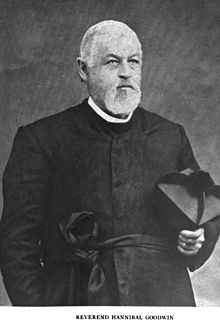Hannibal Goodwin (nonfiction): Difference between revisions
(Created page with "'''Hannibal Williston Goodwin''' (April 21, 1822 – December 31, 1900), was an Episcopal priest at the House of Prayer Episcopal Church and Rectory in Newark, New Jersey. Go...") |
No edit summary |
||
| (2 intermediate revisions by the same user not shown) | |||
| Line 1: | Line 1: | ||
'''Hannibal Williston Goodwin''' (April 21, 1822 – December 31, 1900), was an Episcopal priest at the House of Prayer Episcopal Church and Rectory in Newark, New Jersey. | [[File:Hannibal_Goodwin.jpg|thumb|Hannibal Williston Goodwin.]]'''Hannibal Williston Goodwin''' (April 21, 1822 – December 31, 1900), was an Episcopal priest at the House of Prayer Episcopal Church and Rectory in Newark, New Jersey. | ||
Goodwin patented a method for making transparent, flexible | Goodwin invented and patented a method for making transparent, flexible, rolled photographic film based on nitrocellulose. | ||
He was motivated to search for a non-breakable, and clear substance on which he could place the images he utilized in his Biblical teachings. | |||
On May 2, 1887, the year Reverend Goodwin retired from the church he had served for twenty years, he filed a patent for "a photographic pellicle and process of producing same ... especially in connection with roller cameras", but the patent was not granted until 13 September 1898. In the meantime, George Eastman had already started production of roll-film using his own process. | |||
In 1900, Goodwin set up the Goodwin Film and Camera Company, but before film production had started he was involved in a street accident near a construction site and died on December 31, 1900 from his injuries. | |||
== In the News == | == In the News == | ||
| Line 17: | Line 23: | ||
* [https://en.wikipedia.org/wiki/Hannibal_Goodwin Hannibal Goodwin] @ Wikipedia | * [https://en.wikipedia.org/wiki/Hannibal_Goodwin Hannibal Goodwin] @ Wikipedia | ||
[[Category:Nonfiction (nonfiction)]] | [[Category:Nonfiction (nonfiction)]] | ||
| Line 24: | Line 28: | ||
[[Category:Paintings (nonfiction)]] | [[Category:Paintings (nonfiction)]] | ||
[[Category:People (nonfiction)]] | [[Category:People (nonfiction)]] | ||
[[Category:Priests (nonfiction)]] | [[Category:Priests (nonfiction)]] | ||
Latest revision as of 16:37, 6 July 2017
Hannibal Williston Goodwin (April 21, 1822 – December 31, 1900), was an Episcopal priest at the House of Prayer Episcopal Church and Rectory in Newark, New Jersey.
Goodwin invented and patented a method for making transparent, flexible, rolled photographic film based on nitrocellulose.
He was motivated to search for a non-breakable, and clear substance on which he could place the images he utilized in his Biblical teachings.
On May 2, 1887, the year Reverend Goodwin retired from the church he had served for twenty years, he filed a patent for "a photographic pellicle and process of producing same ... especially in connection with roller cameras", but the patent was not granted until 13 September 1898. In the meantime, George Eastman had already started production of roll-film using his own process.
In 1900, Goodwin set up the Goodwin Film and Camera Company, but before film production had started he was involved in a street accident near a construction site and died on December 31, 1900 from his injuries.
In the News
Fiction cross-reference
Nonfiction cross-reference
External links:
- Hannibal Goodwin @ Wikipedia
